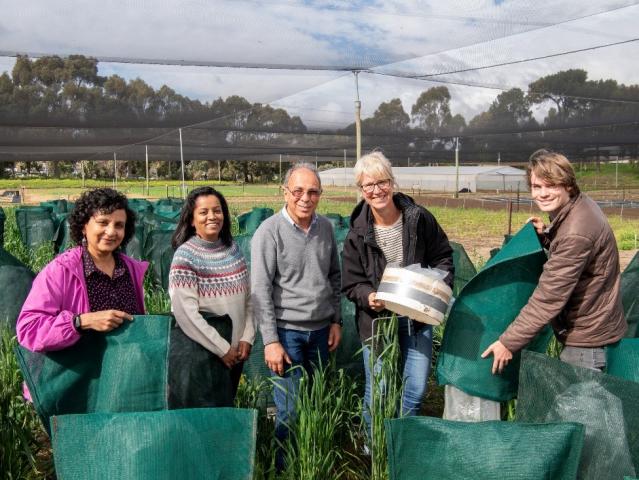
Wheat's multi-foliar disease resistance genomics
Project name
Detection of genomic locations contributing resistance to multiple foliar diseases of wheat
Researchers tackle yellow spot, nodorum blotch, and powdery mildew
Yellow spot (YS), nodorum blotch (NB) and powdery mildew (PM) cost the WA wheat industry more than $200 million each season in lost production and fungicide control costs.
This is despite the use of $150 million in fungicides.
There has been a rise in these diseases in recent years due to implementation of new farm management practices such as minimum tillage, reduced stubble burning, increased wheat-after-wheat cropping and use of susceptible varieties.
Resistant varieties are an important component of an integrated disease management program.
A team of researchers from the Department of Primary Industries and Regional Development (DPIRD) in collaboration with Australian Grains Technologies, InterGrain and LongReach Plant Breeders are conducting research using international genetic sources with broad spectrum resistance effective at various growth stages and environments for one or more of the above diseases.
It was prompted by research co-funded by the Grains Research Development Corporation, which identified the sources of genes with triple resistance.
This research assessed over 2400 wheat lines from around the world.
Some of the findings from this research included:
- 7 lines had moderate to high level of resistance to the 3 fungal diseases.
- One of the seven lines had high levels of resistance for all three diseases.
- Four lines had high levels of resistance for two diseases and moderate levels of resistance for one disease.
Six of these lines have been used to develop doubled haploid populations by crossing with existing parent varieties, which includes King Rock, Hydra, LRPB Havoc, Kinsei, Rockstar and Magenta.
DPIRD Project Manager Manisha Shankar said this work aims to determine the genomic locations contributing resistance to yellow spot, nodorum blotch and powdery mildew through multi-environment assessment and genome-wide genotyping using three of these doubled haploid populations targeting all three diseases.
“It also aims to identify resistant donor lines with broad spectrum resistance effective at various growth stages and environments for one or more of the above diseases.
The research will also help detect resistance genes that account for a large proportion of genetic variation for resistance to one or more of the above diseases.” Ms Shankar said.
Experimental approach
One doubled haploid population is being tested each year.
Replicated experiments are conducted in the field as well as controlled environment.
Disease inoculum is evenly applied to the plants which are then rated for disease severity at various growth stages.
Trials for all 3 doubled haploid populations are expected to be completed in 2025.
The research aims to deliver genetic resources for utilisation in Australian wheat breeding to improve resistance to all three diseases and increase profitability.
The work continues
Each of the collaborators will conduct genome wide genotyping of the three selected populations on their preferred platforms of SNP (single nucleotide polymorphism) arrays.
SNP arrays are a tool for studying slight variations in regions of genes between whole genomes.
Researchers have ticked off 1 of 4 milestones involving one doubled haploid population so far.
This included:
- Successfully completing field and controlled environment trials for all 3 diseases
- Delivering 20 lines with high levels of resistance to yellow spot, nodorum blotch and powdery mildew effective at various growth stages and environments, to Australian breeding entities.
- Genome-wide genotyping and identifying genomic locations contributing resistance to yellow spot, nodorum blotch and powdery mildew.
- Detecting genes accounting for a large proportion of genetic variation for resistance to one or more of the diseases.
Further research on germplasm and genetic tools will enable breeding companies to deliver resistant varieties to growers faster.
Contact
Manisha Shankar
DPIRD Senior Research Scientist
E: manisha.shankar@dpird.wa.gov.au
P: (08) 9368 353
